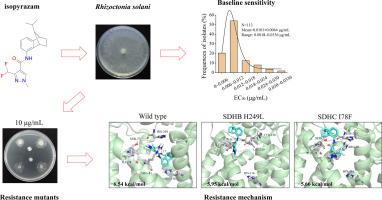索拉根丝核菌对SDHI杀菌剂异吡嗪耐药的分子机制及风险评价
IF 4
1区 农林科学
Q2 BIOCHEMISTRY & MOLECULAR BIOLOGY
引用次数: 0
摘要
水稻纹枯病是世界水稻三大病害之一,琥珀酸脱氢酶抑制剂(SDHI)杀菌剂异吡嗪尚未在中国进行防治注册。本研究考察了茄枯丝核菌对异吡嗪的敏感性,并对其耐药风险进行了评价。结果表明,113株索拉尼梭菌对异吡嗪的敏感性为0.0018 ~ 0.0336 μg/mL,平均为0.0101±0.0064 μg/mL。通过紫外诱变获得10个异吡唑耐药突变体,其中高耐药2个(RF > 100),中耐药6个(100 > RF > 20),低耐药2个(20 > RF > 5)。适应度测试表明,抗性突变体显著降低了菌丝生长和致病性。异吡嗪与氟唑胺交叉耐药阳性,非sdhi杀菌剂未见交叉耐药。对SDH蛋白的序列比对表明,SDHB中的H249L突变与中等抗性有关,而SDHC中的I78F突变与中等至高水平抗性有关。值得注意的是,SDHC-I78F被鉴定为一个新的突变位点。分子对接表明,这些突变降低了异吡嗪与SDH蛋白之间的结合亲和力。因此,我们评估了索拉尼根丝核菌对异吡嗪的抗性风险,范围从低到中等。这些结果表明,异吡嗪在未来具有防治水稻纹枯病的潜力。本文章由计算机程序翻译,如有差异,请以英文原文为准。

Molecular mechanism and risk assessment of Rhizoctonia solani resistance to the SDHI fungicide isopyrazam
Rice sheath blight is one of the three major rice diseases worldwide, and the succinate dehydrogenase inhibitor (SDHI) fungicide isopyrazam has not yet been registered for its control in China. This study investigated the sensitivity of Rhizoctonia solani to isopyrazam and assessed its resistance risk. Specifically, the sensitivity of 113 R. solani isolates to isopyrazam was evaluated, with EC50 values ranging from 0.0018 to 0.0336 μg/mL and an average of 0.0101 ± 0.0064 μg/mL. Ten isopyrazam-resistant mutants were generated by ultraviolet mutagenesis, including 2 highly resistant (RF > 100), 6 moderately resistant (100 > RF > 20), and 2 lowly resistant (20 > RF > 5) mutants. Fitness assays showed that resistant mutants had significantly reduced mycelial growth and pathogenicity. Positive cross-resistance was observed between isopyrazam and thifluzamide, but no cross-resistance was detected with non-SDHI fungicides. Sequence alignment of the SDH protein indicated that the H249L mutation in the SDHB contributed to moderate resistance, while the I78F mutation in the SDHC was associated with moderate to high levels of resistance. Notably, the SDHC-I78F was identified as a novel mutation site. Molecular docking indicated that these mutations reduced the binding affinity between isopyrazam and the SDH protein. Therefore, we assessed the resistance risk of Rhizoctonia solani to isopyrazam as ranging from low to moderate. These findings indicate that isopyrazam has potential for controlling rice sheath blight in the future.
求助全文
通过发布文献求助,成功后即可免费获取论文全文。
去求助
来源期刊
CiteScore
7.00
自引率
8.50%
发文量
238
审稿时长
4.2 months
期刊介绍:
Pesticide Biochemistry and Physiology publishes original scientific articles pertaining to the mode of action of plant protection agents such as insecticides, fungicides, herbicides, and similar compounds, including nonlethal pest control agents, biosynthesis of pheromones, hormones, and plant resistance agents. Manuscripts may include a biochemical, physiological, or molecular study for an understanding of comparative toxicology or selective toxicity of both target and nontarget organisms. Particular interest will be given to studies on the molecular biology of pest control, toxicology, and pesticide resistance.
Research Areas Emphasized Include the Biochemistry and Physiology of:
• Comparative toxicity
• Mode of action
• Pathophysiology
• Plant growth regulators
• Resistance
• Other effects of pesticides on both parasites and hosts.

 求助内容:
求助内容: 应助结果提醒方式:
应助结果提醒方式:


